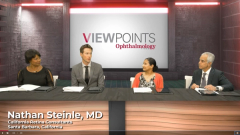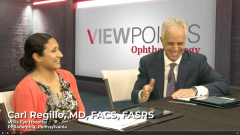
Patient Selection for Faricimab Treatment in Neovascular AMD
Adrienne Scott, MD; Carl Regillo, MD, FACS, FASRS; and Prethy Rao, MD, MPH, discuss patient selection for faricimab in neovascular AMD, as well as approaches to switching to faricimab after a poor response to other treatment.
Episodes in this series

Nathan Steinle, MD: Talk me through your patient selection for faricimab.
Adrienne Scott, MD: When aflibercept first became available to us, we thought this was particularly groundbreaking in the fact that it’s an anti-VEGF therapy that could last up to 8 weeks in those patients. I feel like we learned fairly quickly that not all patients could go the 8-week interval, as we saw in the clinical trial. Therefore, we had to start treating people as frequently as every 4 weeks, or 5 or 6 weeks. So, there are a proportion of patients who can’t go 8 weeks with a dry retina and neovascular AMD [age-related macular degeneration], and a certain proportion of patients who have bilateral disease.
For the patients I’m considering switching and for whom I have switched, I speak with them about the potential dual mechanism, but also there are patients who have what we consider a high treatment burden. In my opinion, and that may vary depending on which retina specialist you ask, but a high treatment burden to me is a patient who has to be treated every 4 to 6 weeks, or less than every 8 weeks, oftentimes bilaterally, and their retina still has evidence of agitation or fluid that we don’t want to tolerate. Those are the people I start talking to about, maybe we’ll switch you over to this longer-acting agent.
Nathan Steinle, MD: Do you have any studies that guide us at all, any evidence? I know there’s the TRUCKEE study ongoing, any thoughts about that study?
Adrienne Scott, MD: Yes, I love the TRUCKEE Study. To Dr Regillo’s point, some of these real-world studies do tell us a lot about the behavior of these molecules and the real setting outside of the clinical trial. So I do feel like we’re able to extend more and more, whatever the trials tell us to do as far as the regimen, we’re going to push it. We’re going to add more and more to the extension period. To me in my hands, I’m still learning about the durability of faricimab in certain patients. I am still impressed at the variability of patients and how they respond to the different agents, so I’m still working that out in my hands.
Nathan Steinle, MD: I’ll throw it back to you guys, to the switchers. Have you been switching patients over to faricimab? What’s been your early experience so far?
Prethy Rao, MD, MPH: I think for me, most of what I’ve been using faricimab for are the switchers. I don’t know about you guys, but I feel like faricimab is almost like a fine wine, and I think the trials support it. After the 1-year period, the differences in their drying effects and their visual outcomes become larger and larger, and I feel like maybe that’s more of the Ang-2 [angiopoietin-2] effect. So when I do switch patients, I don’t go back to the every 4-week mark. I stay at that whatever extended period they are, and I stay on that for a few visits. I’ve noticed that while I might not get a great response initially, if I stick with the medication at that interval, over time they respond better. I try to give it a bit more of a chance rather than they switch once, then it doesn’t work, and they have to switch back to the other drug they were on.
Carl Regillo, MD, FACS, FASRS: I’ve had a good experience, and I definitely see the added durability in switching patients, and these are the hardest to treat patients, right? They are patients who are coming and getting injections to get adequate disease control, and usually, it’s adequate disease control. Sometimes it’s suboptimal, but they have high needs every 4, 5, or 6 weeks. Yes, those are the first patients I’m switching, and I’m seeing them in at least another week or two. I don’t expect to go from every 4 weeks for aflibercept to every 12 weeks or even 16 weeks for faricimab. That’s unrealistic because even faricimab will sometimes need to be administered frequently to keep the disease under control. In fact, that’s why its label is every 4 to 16 weeks, but the vast majority of course will be well beyond that if you take all comers with neovascular AMD.
Transcript edited for clarity
Newsletter
Keep your retina practice on the forefront—subscribe for expert analysis and emerging trends in retinal disease management.















































